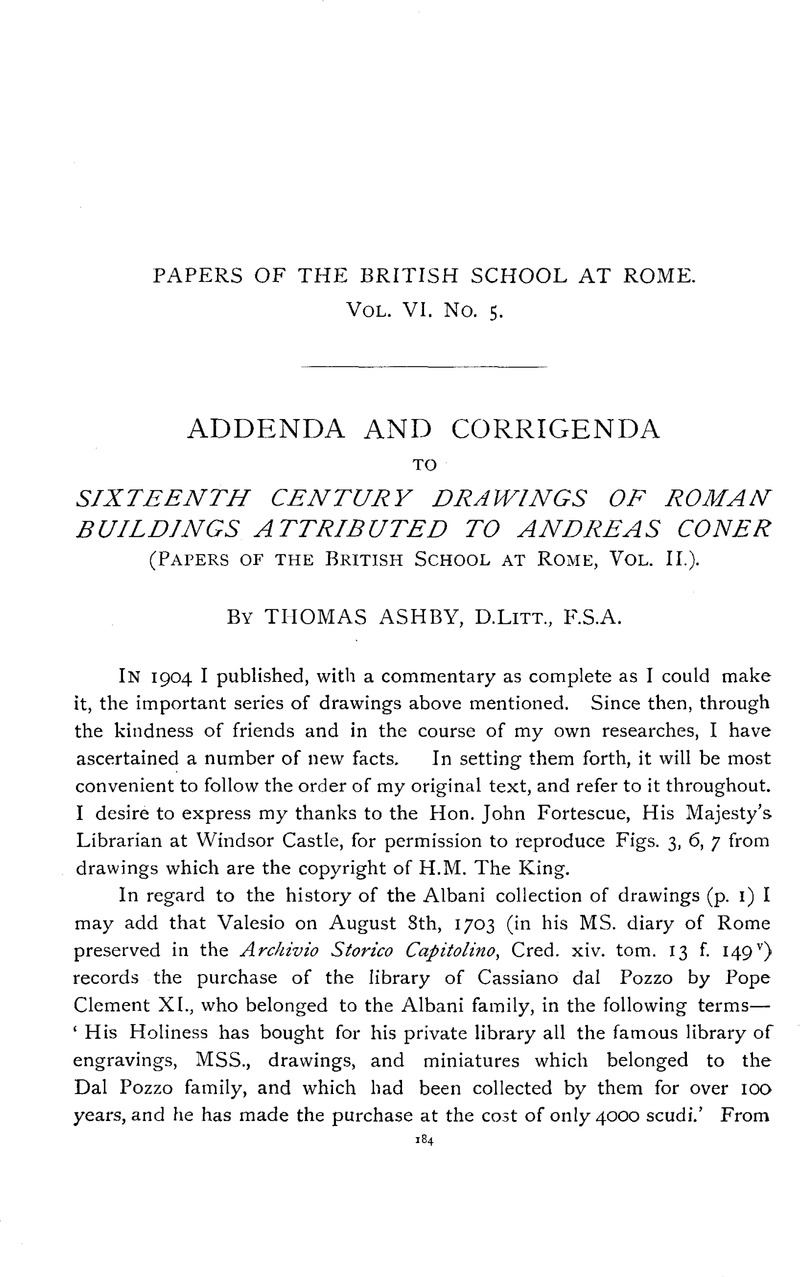Article contents
Addenda and Corrigenda to Sixteenth Century Drawings of Roman Buildings attributed to Andreas Coner (Papers of the British School at Rome, Vol. II.)
Published online by Cambridge University Press: 09 August 2013
Abstract

- Type
- Addendum
- Information
- Copyright
- Copyright © British School at Rome 1913
References
page 185 note 1 The crowned eagle is clear enough; while the object in the other quarters is a ‘pozzo’ (well-head) between two dragons erect (Lumbroso, op. cit. 13: Crollalanza, , Dizionario araldico, ii. 373Google Scholar).
The arms of Carlo Antonio dal Pozzo, which are identical, recur on the title page of the Raccolla delle principali fontant dell' Inclitta Città di Roma dessegnate, et intagliate da Domenico Parasachi, dedicated to him by its publisher, Matteo Gregorio de Rossi, in 1647. The cross of S. Stephen is alone omitted, as he did not become a knight of S. Stephen until after his brother's death in 1657. His son Gabriele retained the collection (Ciampini, , Vet. Mon. i. p. 83Google Scholar a—cuius vestigia sequitur Eques Gabriel filius): it was Cosimo Antonio, his grandson, who sold the library to Clement XI., and the seal is very likely his. The arms in the right-hand half of the shield would then be those of his mother, whose name I have not been able to ascertain, inasmuch as they are not those of the Costa family of Savona, to which his grandmother (the wife of Carlo Antonio) belonged (Lumbroso p. 18).
page 186 note 1 Codices e Vaticanis selecti phototypice expressi, vol. ix. Il libro di Giuliano da Sangallo (codice Vat. Barb. Lat. 4424), Leipzig, 1910Google Scholar.
page 186 note 2 It was this drawing which served as the original of Ciampini, , Vetera Monumenta i. tav. 21Google Scholar, and not that made by Vincenzo Vittoria (Windsor, Cod. Vittoria, f. 42: Inv. 9674) as Hülsen states on p. 80.
page 189 note 1 The watermark of the early sixteenth century paper on which the drawings are—an anchor in a circle, reproduced on p. 2—is a very common type (cf. Briquet 476–495).
page 189 note 3 Prof. Hülsen agrees with him—op. cit. p. xliv. note.
page 190 note 1 Hübner (Le Statue di Roma, p. 52) has discovered that this sketchbook, the later of the two, dates from 1535.
page 193 note 1 Moroni, , Disionario di Erudizione Storico-Ecclesiastica, xi. 311Google Scholar, says that in the time of Alexander VI., or according to others of Julius II., the church was altered in order to open the strada de' Banchi, having previously extended to the middle of that street. Thus it was reduced to a nave 99.palms (nearly 22 metres) long, 37 (a little over 8 metres, whereas our plan gives 15§ bracchia = 9·10 m.) wide, and 33 high. It had a vaulted ceiling, there were seven altars, eight tombs, and a campanile with four bells, the largest of which was cast in 1442. This must be a description of the oval church erected by the canons, and can hardly be what is shown on our plan. It is remarkable, however, that none of the works on the churches of Rome gives a proper description of the church as it was from the death of Julius II. to the time of Clement XII.
page 194 note 1 The expense of building the theatre was partly met by a loan from Bernardino de' Fabii. Jacovacci, Famiglie Romane, letter F, p. 13 (Cod. Ottob. 2550) gives the following extract: ‘Bernardinus de Fabiis mutuo dedit Populo Romano ducatos 600 pro faciendo Theatro in honorem Juliani et Laurentii de Medicis die 29 Augusto 1513’ (Arch. Capitolin. Pacificus Nardus not. f. 2).
page 194 note 2 It is fasc. 206 of the Scelta di Curiosità letterarie inedite o rare.
page 194 note 3 Roscoe is wrong in placing the date of its election in 1513 and attributing the statue to Giacomo del Duca: it was really the work of Domenico Diana of Bologna (Lanciani, , Storia degli Scavi, i. 207Google Scholar: Rodocanachi, Roman Capitol (London, 1906) 71).
page 195 note 1 This was republished by Visconti, P. E. from Venuti's text in L'Album, iv. (1837) 263, 272Google Scholar.
page 196 note 1 Janitschek (p. 269) considers that this refers to the fourth picture on the entrance wall (Guerrini p. 57), a representation of a theatre in which a comedy is being given.
page 202 note 1 It is given also by Forcella, , Iscrizioni delle Chiese ecc. di Roma, vol. i. p. 299, no. 1138Google Scholar.
page 204 note 1 This is the figure given by Torrigio and Gigli.
page 205 note 1 Mr. G. Gordon Leith points out to me that the cornice and the shell above are both characteristic of the architecture of the time of Domitian, who must have to some extent restored the thermae of Agrippa (Jordan-Hülsen, , Topographie, i. 3. 577Google Scholar).
page 208 note 1 I imagine the reference is to the head of the Caryatid brought by Lord Elgin from the Erechtheum.
- 1
- Cited by


